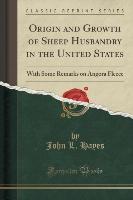Origin and Growth of Sheep Husbandry in the United States
BücherAngebote / Angebote:
Excerpt from Origin and Growth of Sheep Husbandry in the United States: With Some Remarks on Angora Fleece
The lowland sheep of Holland bore many of the characteristics of the English. The compact, short-limbed, heavy-fleeced animal of recent improvement was not then in existence, whether English or Spanish. They were small, agile, wild, slow in maturing, and their flesh was not highly esteemed as food.
While sheep have been bred in this country for more than two hundred and fifty years, it is only within the present century that improved breeds have been introduced, with the exception of isolated cases of partially-improved animals, as the original Leicesters (Bakewells) of President Washington, and the Merinos imported by Mr. William Foster, of Boston, who gave them to a gentleman to keep, by whom they were "kept" and eaten! In 1801 four Spanish rams were embarked for the United States by M. Dupont de Nemours, chief of a French commission to select sheep in Spain under the treaty of Basle, and a banker named Delessert, but only one lived to reach New York. It went to Delaware, and was used effectively in producing valuable grades. Yet the founding of the improvement which ultimately produced the American Merino bears the date of 1802, when our minister to France, Mr. Livingston, sent home two pairs of French Merinos (originally Spanish Merinos which had been modified by a course of breeding) from the imperial flock at Chalons. In the same year our minister to Spain, Colonel Humphreys, brought home with him 21 rams and 70 ewes from the best flocks of the fine-wools of Spain. From these and subsequent importations, aided by three-fourths of a century of skillful breeding, came the best race of Merinos now extant, which has modified, in greater or less degree, more than nine-tenths of the flocks of the country, changing the natives or scrubs of different origin into Merino grades, doubling the weight and value per pound of their fleeces, and transmuting fibers little better than the carpet-wools of nomadic sheep-husbandry into the fine and soft material for clothing fabrics and the longer staple of Merino combing.
The improvement was rapid. In 1810 one of Mr. Livingston's yearling rams weighed 145 pounds and bore a fleece of 11 pounds 11 ounces, and his full-blood ewes averaged fleeces of 5 pounds 13 ounces, 60 percent. more than his best common ewes, and the maximum weight was 8 pounds 12 ounces, while the first cross made an improvement amounting to fully 50 percent.
Recent as is the improvement in this country, it is nearly as old as in Europe. Great Britain tried the Spanish sheep, but the demand for mutton, and the necessity for worsted wool, gave impulse to progress in another direction, upon a foundation of original Leicesters and Lincoln and Southdown blood. The first year of the present century found that country dependent on Spain and Portugal for foreign wool, and of the meager importation, amounting to only 8, 609, 368 pounds, these countries sent respectively 6, 062, 824, and 1, 731, 934 pounds, while Germany sent 412, 394 pounds, and the Netherlands 141, 739 pounds.
About the Publisher
Forgotten Books publishes hundreds of thousands of rare and classic books. Find more at www.forgottenbooks.com
This book is a reproduction of an important historical work. Forgotten Books uses state-of-the-art technology to digitally reconstruct the work, preserving the original format whilst repairing imperfections present in the aged copy. In rare cases, an imperfection in the original, such as a blemish or missing page, may be replicated in our edition. We do, however, repair the vast majority of imperfections successfully, any imperfections that remain are intentionally left to preserve the state of such historical works.
Folgt in ca. 5 Arbeitstagen
